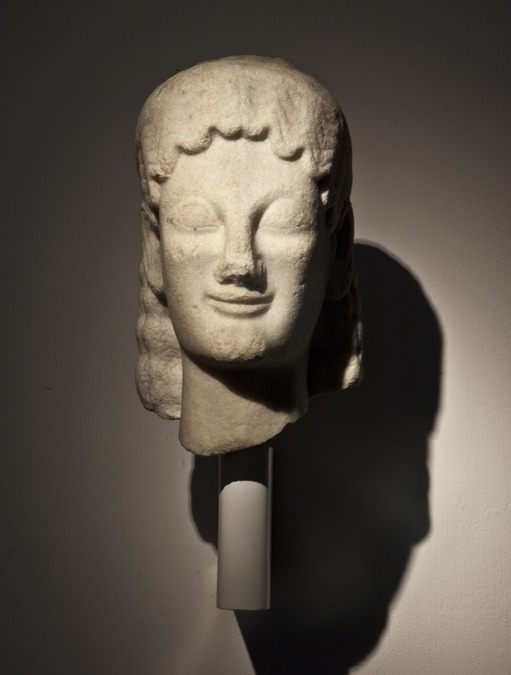Sphinx’s head
Summary
The surface of the limestone is very weathered, almost without patina. The head is parts of the face and meniskos. On the neck a painted pattern in red and black can be seen with the naked eye and with raking light. A reconstruction of the sphinx with it’s original body and overall painting has been made.
Description of object
The hair falls in a broad mass down the back, in strings of ringlets, and is held in to the head by a broad frontlet, while the neck hair is held together by a narrower band behind the ears. The part between the two bands is rendered with a simplified graphic pattern of strokes, which under the broad band continues in ringlets. The hair of the forehead waves freely and is parted in the middle. The large swollen eyes are the most expressive feature of the face. The mouth is drawn up in a subtle smile. The chin is very marked. The ears are long and narrow with large lobes.
The back head is broken away during the forceful removal of a metal meniskos, of which there are remains. Tip of nose, chin and cheeks slightly damaged.
Choice of methods
Visual examination
- Macroscopic
Technical imaging
- Raking light
Marble identification method
- Isotopic analysis. Results: d13C, 1,78 - d18O, -0,91. Origins inconclusive: Either Hymettos or Carrara. Could also be: Paros/Chorodakia or Aphrodisias.
Bibliography
F. Poulsen (1951), Catalogue of Ancient Sculpture in the Ny Carlsberg Glyptotek, Copenhagen, cat. no. 18a.
F. Johansen (1994), Catalogue. Greece in the Archaic Period. Ny Carlsberg Glyptotek, Copenhagen, cat. no. 8.
V. Brinkmann (2003), Die Polychromie der Archaischen und Frühklassischen Skulptur, München, fig. no. 237.
- IN 2823
- Head
- c. 570-560 B.C.E.
- Archaic
- White marble -perhaps Hymettian.
- Bought in 1935 from Coll. Wix de Zsolna.
- H. 27.5 cm.; W. 17 cm.; D. 21 cm.


